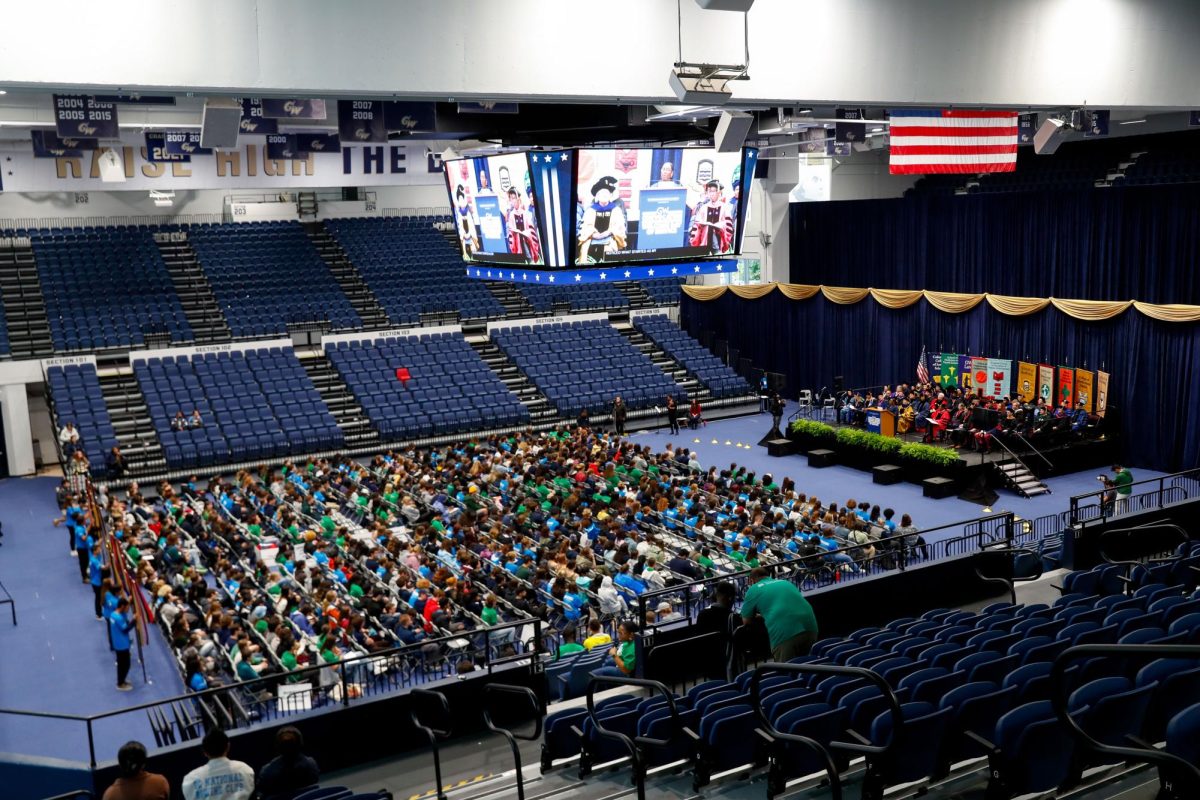GW’s undergraduate acceptance rate dropped by more than five percent this year, according to the University’s annual enrollment update presented at a Faculty Senate meeting last month.
GW accepted 43.5 percent of applicants for the 2023-24 academic year — an intentional 5.5 percent decrease from the 49 percent rate in the 2022-23 year and 49.7 percent acceptance rate in 2021 — placing the University’s selectivity in line with 2020’s acceptance rate of 43 percent. Vice Provost for Enrollment and Student Success Jay Goff said acceptance rates can fluctuate based on several factors, like the quality of applicant pools.
Goff declined to comment on why officials set a goal to lower the acceptance rate for 2023 and what practices officials implemented to achieve a lower acceptance rate. He also declined to comment on whether officials plan to maintain the 43.5 percent acceptance rate or lower it any further, how officials avoided negatively impacting academic quality, diversity and tuition revenues while lowering their acceptance rate and how enrollment limits set by the D.C. government influenced how many applicants officials choose to accept.
Last year, experts said GW’s acceptance rate hike from 43 percent to 49 percent could deter some applicants who care about selectivity when choosing what university to attend. Despite the reduced acceptance rate this academic year, the number of applicants has remained relatively steady. GW received 27,094 applications in 2023 and admitted 11,798 students, compared to 27,266 applications and 13,354 admitted students in 2022.
Officials aimed to enroll between 2,500 and 2,550 first-year students in 2023, the lowest number since 2020, and 2,539 students matriculated into the University, according to the enrollment update. In 2022, GW enrolled 2,941 new first-year students, the largest new class since 2018.
“Due to a decrease in international applications as a result of the COVID-19 pandemic, as well as a smaller pandemic class of 2020, the university saw additional capacity for a larger first-year class in 2022,” Goff said in an email.
The national average acceptance rate for private colleges was 70 percent in 2021.
Experts in higher education administration say officials may have reduced GW’s acceptance rate to make the University’s selectivity more similar to peer institutions.
Brendan Cantwell, a professor of higher, adult and lifelong education at Michigan State University, said GW could have admitted a smaller portion of its applicant pool to imitate the competitive admissions of market-basket institutions.
“‘Boston University admits a smaller share of students than we do, and we want to be more in line with our main competitors, like BU or Georgetown,’ and so that might be the kind of thing that’s going on,” he said.
Out of GW’s 12 peer schools, only two — Syracuse University and the University of Pittsburgh — had higher acceptance rates than GW in 2022, with 52 percent and 49 percent respectively. GW and its peer schools had an average acceptance rate of 23.6 percent in 2022, according to institutional data.
Cantwell said it is possible that GW could also reduce its acceptance rate to accommodate more graduate students or because of the University’s capacity limits. He added that the stronger emphasis in the U.S. News and World Report methodology on social mobility factors in college rankings, like how universities improve the financial standing of graduates, led to lower rankings for more selective private colleges.
Cantwell said he anticipates schools will not be as concerned with acceptance rates in the future as a result.
“If GW were to become hyper-selective and go down to admitting 20 percent of students or 18 percent of students, and its reputation increased as a result, then there might be kind of a halo effect where current students are seen as having been extra-competitive students because they went to a university that’s now harder to get into. But in general, there’s not much of a change for current students,” he said.
Jon Boeckenstedt, the vice provost of enrollment management at Oregon State University, said GW may have lowered its undergraduate acceptance rate to bolster the enrollment of transfer students.
GW admitted 274 transfer students for the 2023-24 academic year compared to 44 in 2022, according to the enrollment update. The enrollment data did not provide the number of transfer applications GW received in either school year.
“The public seems ambivalent about transfer admit rates, and in fact, they are not generally collected or published in federal sources, so that could rise to 100 percent, and people wouldn’t care or even notice,” Boeckenstedt said.
Boeckenstedt added that GW may be looking to make its acceptance rate more selective to match peer schools like New York University and Northeastern University. In 2023, Northeastern and NYU had 5.6 and 8 percent acceptance rates, respectively.
“Colleges often compare themselves to other institutions that either are peers or that the college wants to be peers with and if those institutions are more selective, some people suggest our college should be,” he said.
Mark Babunovic, an independent college counselor based in Northern Virginia, said GW’s reduced acceptance rate will likely increase diversity on campus because officials have more flexibility in selecting diverse applicants with a larger applicant pool.
“I would imagine that everything else equal, [the lower acceptance rate] probably means a more diverse student body because that’s what admissions committees in a lot of respects are looking for,” he said.
Babunovic said acceptance rates for more selective private colleges have declined in recent years. He said applicants will apply to more schools as a result of the lower acceptance rates. Harvard University had a record-low acceptance rate of 3.19 percent last year, and Columbia University had a record-low acceptance rate of 3.7 percent in 2021 and 2022.
“[Applicants] are reacting by diversifying across more applications and, I think, scaling back their expectations and realizing that a lot of these schools are just out of their reach,” he said.





